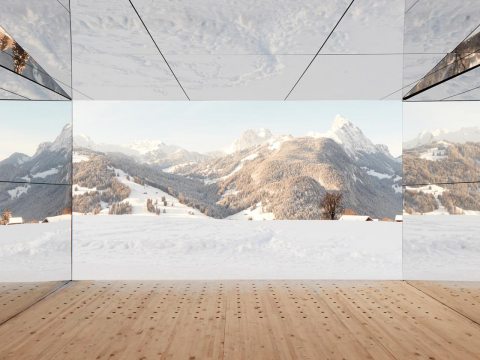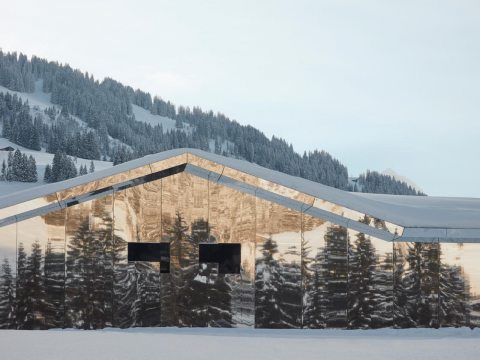During the intensive planning phase of one and a half months, the NUSSLI engineers developed a structure that meets all design and structural requirements.
Since the outdoor sculpture can be entered by the public, is erected in the mountains and also remains in place throughout the winter, the static regulations require that its roof can withstand snow loads of up to 470 kg/m2 - a weight corresponding to approximately 65 Tesla cars.
The artist designed the entire facade completely mirrored and without the mounting system being visible. The NUSSLI team tested various mounting options and materials to ensure that the facade's panels would not warp neither in warm summer nor in cold winter temperatures and would always have a uniformly flat, reflective surface.
Within two weeks, a timber substructure was erected on a temporary screw foundation, which was then cladded with the mirrored composite panels over the course of four weeks, using a specially developed suspension system. Apart from the floor, all walls have a reflective surface on the inside and outside.
The footprint of the art installation measures 180 square meters and it is located along a hiking trail at an altitude of 1100 meters. The location made the logistics more challenging, as the loads had to be transferred from large trucks to a smaller vehicle.
Working together with Vogelwarte Sempach (Swiss Bird Protection Society), horizontal black lines were installed every three centimeters on the facade to counter the distraction from the reflective surfaces for migrating and breeding birds and to make the building visible to them. The structure was also verified via 3-D model for no interference with sunlight reflection during the year for neighbors and air traffic.
For more information and live webcam, go to www.elevation1049.org
About Elevation 1049:
Elevation 1049 first took place in 2014 and is named after Gstaad's altitude above sea level (1049m). The project exhibits work by international artists conceived according to site- and time-specific criteria. Most of the pieces are displayed, activated or performed outside in and around Gstaad, aiming to revive dialogue between the creative community and the region.
Elevation 1049 opened its third winter edition Frequencies over the weekend of 1-3 February 2019 and was curated by Neville Wakefield and Olympia Scarry. Produced by the Luma Foundation in collaboration with The Store X Vinyl Factory.
Time and space are the measure of all landscape and the idea of frequency carries that measure within its dual meanings. Frequency is both the rate at which something occurs or is repeated over a given period of time or in a given sample, and also, the rate at which a vibration occurs that constitutes a wave, either in a material (as in sound waves), or in an electromagnetic field (as in radio waves and light), usually measured per second. The third edition of Elevation 1049 invokes both of these ideas.
Mirage Gstaad by Doug Aitken (born in 1968, Redondo Beach, California, USA) uses the frequency of light to reflect the sublime Alpine landscape as part of a continually changing encounter in which land and sky, subject and object, inside and outside are in constant flux. Standing in contrast to the surrounding chalet’s the ranch-style structure suggests a latter-day architectural version of Manifest Destiny, the westward migration that began in Europe and finally settled in California. With every available surface clad in mirror it both absorbs and reflects the landscape around in such ways that the exterior will seemingly disappear just as the interior draws the viewer into a never-ending kaleidoscope of light and reflection.







